This post comes with a little explanatory video (12 minutes running time) as an introduction to my Luna Trick pea project. It's the first time I've made one of these, so do let me know if it's useful.
Luna Trick is a new pea variety I'm working on. It's an exquisitely tasty edible-podded pea with pale golden yellow moon-shaped pods - named for my music partner Daniel Staniforth who has a music project called Luna Trick.
The project originally started as an attempt to breed a yellow sugarsnap pea. In 2007 I crossed Golden Sweet, a unique heritage golden-podded mangetout pea, with a modern sugarsnap pea, Sugar Ann. The result was a spectacular range of unexpected colour and flavour diversity - but sadly no yellow sugarsnaps. My chance of getting a yellow sugarsnap in the F2 generation was one in sixteen (a double recessive combination), but none showed up in that particular batch. I had yellow mangetouts and green sugarsnaps, but that was it. However one mangetout plant did stand out from all the rest for its elegant beauty, high yields, juicy golden yellow pods and truly exquisite flavour. This plant, which was numbered YSS 25, became the prototype for Luna Trick.
In 2009 I grew out 35 seeds from this one plant. I was hoping to get more plants of a similar type. And so I did - and a lot more besides!
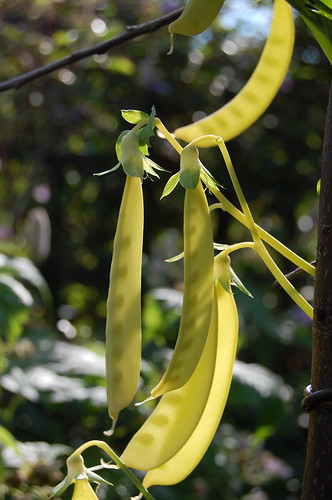
The first Luna Trick yield. Golden yellow moon pods, exquisitely sweet and completely fibreless.
Hybrid vigour in peas is something I've often wondered about. I've often heard it said that hybrid vigour exists only in outbreeding plants, if indeed it exists at all, which is still a subject of debate. Peas are inbreeding plants - very inbreeding - and so you might expect them not to gain much vigour from being hybridised. However my experience is that peas do have a bit of a wahey in their size and growth when you hybridise them. It varies, but it's usually apparent in one way or another. And it may be the reason why Luna Trick turned out a lot taller than expected.
The parent varieties were 5ft tall and 1ft tall respectively. Under normal circumstances, I would expect most of the offspring to be around 5ft tall, as that's the dominant form - with about one in four defaulting to the recessive 1ft size, and maybe the odd intermediate. As it turned out, the dwarf types were nearer 2ft, and voluptuously chunky. Whereas the tall types - well frankly they didn't want to stop.
Daniel, in whose honour the peas are named, is a big bloke. He's 6' 4". I never thought the plants would get as tall as him, but they did.
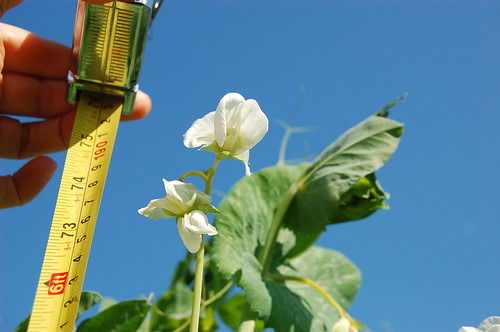
The F3 crop reaches the same height as Daniel. I wasn't able to measure it after this point because my arms aren't long enough.
Most of the plants weren't going to stop there either. They just kept going, way beyond the 5ft tall frame I'd optimistically provided for them. I had to ram some extremely tall and sturdy poles into the ground all around the frame and wrap masses of garden twine around them to hold everything together. And still the plants kept growing. I couldn't even reach the tops. They were probably a good 8ft by the time they started slowing down.
But apart from this, they behaved very well and did everything I hoped they would do. I'm very optimistic indeed that they will turn out to be a wonderful variety. Not only that, they are TWO wonderful varieties. The original YSS 25 protoype plant was a mangetout type - but growing its offspring revealed the presence of a hidden recessive sugarsnap gene, and a large number of the F3 plants turned out to be sugarsnaps. Beautiful, crescent-podded, golden yellow sugarsnaps! So I got exactly what I had wanted when I made the original cross - in addition to developing Luna Trick as a mangetout type. A wonderful, beautiful and very much appreciated gift.
The key trait in Luna Trick is flavour. I'm aiming for it to have the same flavour as YSS 25, which stood out from every other plant in the F2 batch and was among the most refined mangetout flavours I've ever tasted. Very sweet and juicy, but there's a lot more to it than that - it had a rich and refined complexity to its flavour and no trace of bitterness. YSS 25 was good enough that you would want to eat its full size pods straight off the plant. A salad mangetout, effectively, because it tastes so good raw you really would have no incentive to cook it. I think a yellow mangetout which tastes good enough to include in a salad, even at full size, would be a very nice thing to have.
At the moment I'm getting a mixture of single pods and double pods - some plants produced one or the other but in many cases there was a mixture of both on the same plant. I'm not quite sure how this trait works - it is clearly partly genetic but I'm not sure whether there are environmental factors involved too, or a complex interaction of genes, because it doesn't follow normal patterns and ratios. Consequently I'm just not worrying about it for the moment. Two pods per node is often deemed more desirable but I tend to find that the two pods have fewer peas in them compared to the single ones, so I'm not convinced it actually matters that much either way.
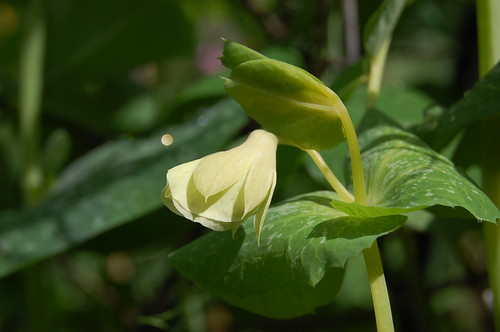
A single flower bud. This is an unusual colour combination in peas - a white flower with a creamy blond calyx (the pixie hat bit).
To summarise the F3 characteristics ...
Luna Trick is stable (true-breeding) for:
Yellow pods - a very simple recessive gene is responsible for this, called gp. In order to express yellow pods, the Luna Trick prototype must have had the stable gp gp genotype. Which is fine by me. It holds only gp genes, so all its offspring will be gp gp too.
There is, however, some variability in how persistent the yellow colour is. One of the weaknesses of the parent variety Golden Sweet is that its pods tend to green up as they reach maturity, so only the young pods are truly yellow. Some of the Luna Trick F3 plants shared this tendency, but others were notable in their ability to stay yellow right up to the time they were harvested for seed. Presumably this is a genetic variable - though I don't yet know how it works - and I will select for it at the F4 stage.
Edible pods - a slightly more complicated trait, as there are two genes involved in the reduction of fibre in the pod, p and v, both recessive. They work in slightly different ways, and you need both of them to get a really good fibreless pod. I have my suspicions that Golden Sweet only has one of them, as it tends to go a bit gristly at maturity. However, Sugar Ann has them both - and now Luna Trick has them both too. There was no trace of fibre in any of the pods in the Luna Trick F3. Hurrah!
White flowers - peas need a dominant gene called A in order to "switch on" anthocyanin production. Without it, they cannot produce any purple pigment in the leaves, stems, flowers, seeds or anywhere else. Luna Trick has inherited the recessive a a genotype from Sugar Ann, and therefore cannot produce colour pigments. White flowers it is then.
Cream calyx - the flowers all have a cream calyx (sometimes with green mottling) rather than the more conventional green. This is a true-breeding trait because it's directly related to the yellow pods. It looks absolutely gorgeous with the white flowers and really gives this variety an extra beauty factor in the garden, adding to its luna blondness.
Luna Trick is still segregating for:
Height - I'm selecting for tallness, which is the work of a dominant gene called Le (internode length). The cross with Sugar Ann will have introduced the recessive type le into the mix. Although the Luna Trick prototype was tall, it had the recessive shortie gene lurking in its genome … and by a simple Mendelian ratio I ended up with dwarf types in about a quarter of the F3 plants. With a bit of luck the F4 generation should take care of this. By growing out several plants from each of several lines, I'm hoping to be able to identify the lines which produce only tall plants, and which are therefore likely to have the desired Le Le genotype.
Pod type - the prototype Luna Trick had large mangetout type pods, which represent the dominant form. However, squirrelled away in its genome was the recessive gene n, inherited from Sugar Ann, which gives sugarsnap type pods. Consequently about a quarter (or just over actually) of the F3 plants were sugarsnaps. I was overjoyed by this, as yellow sugarsnaps were the original intent when I made the cross. The way this gene works is to thicken up the pod wall, giving it its chunky and succulent 'snap' characteristic. To compensate for this thickening, sugarsnap pods tend to be slimmer. Although this genetic difference is simple and made by a single gene, it effectively creates a separate new variety.
The recessive nature of gene n means that any sugarsnap lines I follow up will be true breeding for sugarsnap pods, as they will be genotype n n. The mangetout Luna Trick, on the other hand, will continue to throw up the odd sugarsnap from recessive genes hidden away, and I'll have to eradicate those through repeated selection.
Even within the mangetout type, differences in pod size and shape are apparent. The ideal I'm looking for is a fairly wide crescent shaped pod, but some are narrower and some are extra wide, and some are not quite so crescent-shaped.
Flavour - this is the most important factor, and I would have liked it if all the offspring had tasted as good as the prototype - but only some of them did. I know very little about the genes involved in pea flavour. The combinations are very varied, and so I assume a number of genes have a bearing on it. Sugar content obviously is a major factor, but it's not the be-all and end-all. Some peas taste very sweet but are still quite bland, others have a rich and interesting flavour but aren't particularly sweet. There is also a kind of 'soapy' taste which peas are prone to which seems quite independent of the other flavour variables. The flavour variability in the Luna Trick F3 was quite considerable. They ranged from something akin to nectar of the gods to something bordering on bitterness. Some were just bland. Overall though, the vast majority tasted substantially better than Golden Sweet - and the best ones were truly exceptional. So I'm confident of creating a flavour benchmark with Luna Trick - it's just going to take a bit of careful selection.
Seed colour - the Luna Trick prototype was heterozygous for seed colour, producing both the dominant cream seeds and the recessive green ones. Some of the resulting F3 plants were homozygous for green seeds, but the lines I'm most interesting in following up happen to be heterozygous ones, so the variability will continue in this coming generation. I'm not too bothered about this. I might select one colour or the other if it becomes easy to do so, but I don't see any harm in having the variability. It would be unacceptable in a commercial variety to have mixed cream and green seed, but I don't see why not. One of the compensations of public domain plant breeding is that you're not bound by rules and conventions.
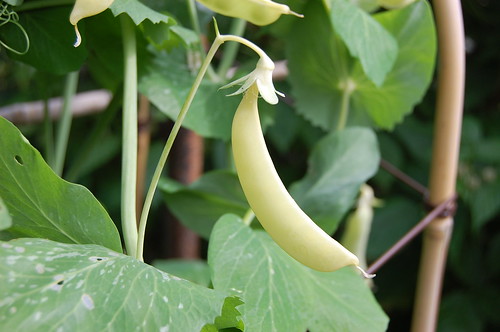
Sugarsnap version of Luna Trick. I will develop this type separately and make a new variety with a different name.
Luna Trick does have a potential weak spot which may be genetic or environmental or a combination of the two. The peas have a tendency to split their skins when ripe - much as ripe tomatoes do when they're over-watered. This isn't a problem when you want to eat them, but verily 'tis a bugger when you are saving them for seed. In the F3 crop, some plants suffered badly from it and some had no problem with it at all. So I am selecting the ones that didn't have the problem - kind of by default, because the ones that have split will not make good seed for replanting. If it's a genetic issue, selecting against it should soon eradicate it. If it's environmental (affected, for example, by how much water the plants get at a particular time) then no amount of selecting will make any difference. So far this seems to be the only flaw though in an otherwise wondrous variety.
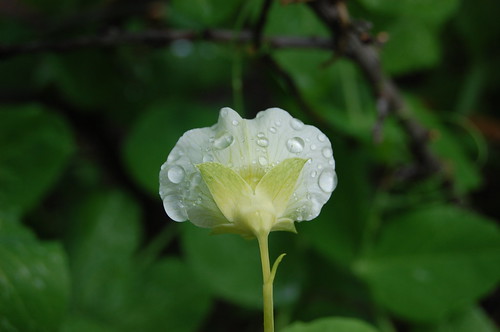
Rain on Luna Trick blossom.
So what now? The F4 crop in 2010
I've already sown 100 seeds for this year's selection work - 50 mangetouts and 50 sugarsnaps - and these are the ones shown in the video above. Germination was 100%.
I'm working on the mangetout and sugarsnap versions as completely separate varieties, and at some point the sugarsnap one will get its own name. Some sugarsnap types will continue to show up among the mangetouts in this generation. I'm also seeing height variability, which is apparent even at the seedling stage.
I've chosen F4 seed from the best six plants of the mangetouts and the best six plants of the sugarsnaps. In the F3 there was one plant, called LT10, which stood out from all the others - it was the tallest, highest yielding, most beautiful and had the holy grail flavour I was looking for. So I'm growing more of those than any other, hoping that I can stabilise it pretty much as it is. But by growing out a few other good lines alongside it, I'm hedging my bets in case LT10 turns out to have any unexpected flaws - and also learning more about the genetics involved, by observing the ratios for different traits in different lines.
With the sugarsnaps, there was no obvious standout plant in the F3. Some were better for flavour, some for pod shape or colour, some for stringlessness ... so I've just selected the six that looked most promising and will see what I get.
All in all though, I'm very excited and optimistic about Luna Trick.
17 comments:
Loved the video, you're a natural! Looking forward to the next episode ;-) Loved the music too. Great to see the preson behind the blog at last. So glad you are able to continue the blog, by the way, I really missed your posts last year.
Sounds like a couple of good varieties! Will they be available via Real Seeds too?
Haven't watched the video yet as I'm at work and don't have Flash on my work PC!
Thank you Phil, it's always good to have some encouragement. Very pleased you enjoyed the video and the music!
Jude, I haven't spoken to Real Seeds yet about whether they're interested in this variety, but I will certainly give them first refusal on it. They are probably the only seed company in the country who are actively working with and encouraging amateur plant breeders.
Will watch the vid later - we've had the Britain in Bloom judges in the village today so I'm feeling rather raddled and in need of me tea.
It's very helpful reading what you are doing as I'm 2 years behind you with my first pea cross - growing out the F2 this year.
So once you have stabilised LT in your own "lab" how long does it take to develope it to a scale where it could be commercially available? Presumably someone like Real Seeds would need to grow on several generations to physically produce enough peas?
And when can we expect the RHS field trial :).......
Just seen the video. It's good to see you so enthusiastic. (I'd be!)
Excellent post, excellent informative video, excellent breeding work - nuff said
Wonderful work! It had occurred to me that pea pods of a non-green colour when ripe for the picking would be a great idea. This would solve the frustration of not finding a hidden pod until it was past its flavour peak. I am pleased that someone has taken up this challenge.
(Andrew - a fruit breeder)
Enjoyed the video and the music. Glad you've updated the blog. I was itching to find out the progress.
Great video and write up about your breeding work. Really informative!
I loved the music, and really the whole video was very nicely made.
Kath, you're doing brilliantly with your F2 plants. You've got through the waiting stage and now you're into the exciting bit - and I'm sure something wonderful is going to come out of it.
Andy, that's the frustrating bit - even when I get it stable enough to send to someone like Real Seeds, it will probably take two or three years to bulk up it up. I think they have to produce a kilo or so of seed themselves and then send it out to a commercial grower for a field-sized growout. Still, nobody takes up plant breeding for the instant gratification!!!
Andrew, yes indeed, there are some very tasty green podded mangetouts out there but it would be nice to have something more interesting.
Raymondo, Patrick - glad you like. Daniel will be pleased that the music is going down well - he wrote, sang and played all the instruments on that song, which will be on the next Luna Trick album. I wanted to use something that was mostly his work, as they're his peas!
thanks for explanation in the video - kudos to your efforts, results and way of explanation.
Congratulate your frind on the music - perfect. Made me really longing for longer summer days....
will be visiting more often.
Am totally new to all this and confess that much of it confousels me a litttle; will have to re-read this great post many times before it all sinks in. Thank you so much for sharing this information so generously.
Ewa - thank you. Daniel reads and appreciates the comments about our music.
Bilbo - actually I'm just grateful that you took the trouble to read it. It is a dense subject, and I often struggle write about it clearly. I'll be honest with you, when I read other people's plant breeding blogs I usually have to read through a few times to make sense of them. It's fascinating stuff but it sinks in slowly! It means a lot to me that you stuck with it.
What a lovely reply, and unexpected - you're very welcome.
I shall come back and read this again, and also watch your video when I have a moment. I have known Flummery for many years and her breeding experiments had already piqued my interest . . . this way lies madness, me thinks! (and it's not like I don't already have more than enough to do, there are just not enough hours in the day)
Such a great information you have. I really appreciate that. I must share this one with my good feinds. Keep it up. Now it's time to avail Baby Liquid Soap for more information.
كل الشكر والتقدير اعمال مميزة ايضاء تستحق شركة "ولاد البلد" التحية والتقدير على الخدمة المتميزة التي تقدمها في مجال الخدمات المنزلية. يُعزز الالتزام بالجودة والاحترافية من سمعتها كمزود أساسي للخدمات التي تناسب متطلبات الحياة الحديثة. مستقبل الشركة يبدو واعدًا، حيث تستمر في تطوير خدماتها وتوسيع شبكة عملائها، مما يجعلها الخيار الأول لعائلات كثيرة تبحث عن الراحة والموثوقية في خدمات المنزل.
ولاد البلد خدمة المنزل
ولاد البلد الامارات
ولاد البلد قطر
ولاد البلد مصر
ولاد البلد البحرين
Post a Comment